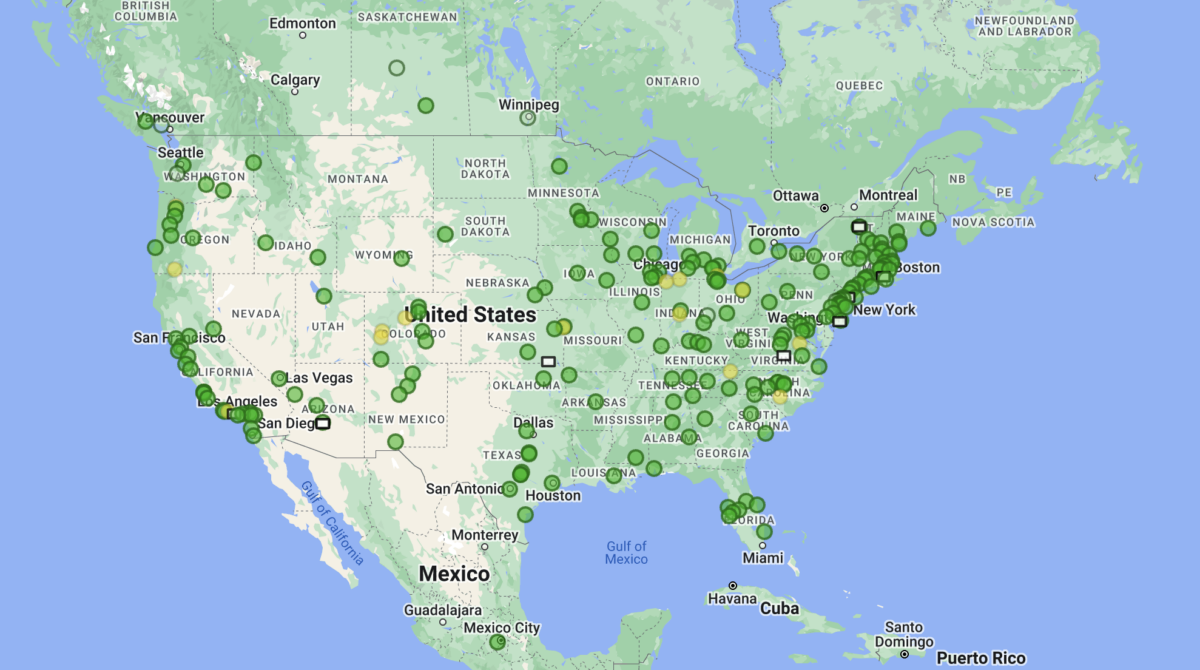This month is your chance to learn everything you wanted to know about electric vehicles (EVs) and even test drive one. National Drive Electric Week is September 22 through October 1, and—seemingly in sync with this annual series of events across the country—we soon will see the 1 millionth electric vehicle sold this year. It took a decade for the U.S. to sell its first million EVs, two years to reach the second million, and just over a year to reach the third. More people are making the choice to drive a cleaner vehicle.
National Drive Electric Week is an opportunity to collectively celebrate the progress made toward reducing emissions from the transportation sector in the U.S. and give Americans the chance to take the wheel. For example, Louisville, Kentucky, is hosting an event where locals can meet enthusiastic EV owners and their array of vehicles, take a test drive, and enter a raffle. More than 200 EV drivers will participate in an October 1 event in Dallas, Texas, with “Ride and Drive” opportunities available to the public (along with food and games). And in Las Vegas, Nevada, on September 30, folks can “see and test drive the latest models, speak to dealers and drivers, and discover the great electric driving experience.”
Transportation is the #1 source of carbon emissions in the U.S. and making the choice to switch to an EV can reduce those emissions. Many of the harmful pollutants emitted by burning gasoline in traditional internal combustion engines (ICE) cause or exacerbate serious illness.
National Drive Electric Week Events

Why Drive Electric?
With fully-electric vehicles making up about 7.3 percent of new-car sales in the U.S. within the first half of 2023 (5.8 percent in 2022, 3.2 percent in 2021), there’s a lot to look forward to in our mobile clean energy transition.
With a federal goal to have 50 percent of all new car purchases be electric by 2030 and nine states adopting policies to accelerate the transition to EVs, the U.S. is poised to make a massive shift in electrifying the transportation system. Now is also good timing to test drive an EV with 10 new models on sale in recent weeks, bringing to 51 the number of battery-powered cars and trucks Americans have to choose from—compared to at this time last year, when only about 30 models were available.
EVs bring cleaner air, healthier communities, and zero tailpipe emissions. And, as EV drivers at Drive Electric events will attest, EVs are easier to maintain and it’s nice to avoid gas pumps altogether. More EVs are coming out every year and with new tax credits for new and used EVs, they are becoming the more affordable and better choice when you need to drive.
Pollution caused by vehicles is a particular concern to low-income areas and communities of color. These communities historically have been directly affected by transportation-related pollution due to decades of racist land use policies and disinvestment. Switching to cleaner EVs is one way to both reduce emissions for all and protect impacted communities as the U.S. progress in our clean energy transition
Ensuring Equitable EV Accessibility
Thanks to the federal Inflation Reduction Act (IRA), purchasing an EV is more cost-efficient than ever – and soon to be cheaper than traditional gas-powered cars. The IRA makes available up to $7,500 in tax credits and direct rebates that offset up-front costs. If EVs are to make significant inroads in U.S. auto sales—and thereby make a dent in carbon emissions—then the benefits of EVs should be available to all segments of the population. Currently, the distribution and adoption of EVs is rarely equitable, with lower sales among low- and middle-income communities and communities of color. This is the case even though EVs help address important environmental health concerns that disproportionately impact these communities, including air quality and noise pollution.
For EVs to truly proliferate, charging infrastructure must serve the diverse American population, beyond those able to charge at home (about 80 percent of charging today). Ensuring equity in EV adoption requires actions ranging from improving EV selection at car dealerships to thoughtfully distributing charging stations, including in rural and underserved areas. Another key challenge is ensuring that the rebates offered for EV purchases are equitable. U.S. Energy Foundation (EF) grantee The Greenlining Institute, in partnership with Towards Equitable Electric Mobility (TEEM), analyzed electric vehicle rebate programs across the country on measures of equity, such as income cap, upfront cost, and accessibility, in order to offer examples of how rebate programs should prioritize the specific needs of these communities.
A variety of groups are working to advance shifts in this space by helping under-resourced community-based organizations, municipalities, business, and others with electrifying their infrastructure and fleets. These include ChargerHelp, EVNoire, and the many BIPOC (Black, Indigenous, and People of Color)/environmental justice community-based organizations associated with the U.S. Environmental Protection Agency’ (EPA) Thriving Communities Technical Assistance Centers.
Addressing Barriers to EV Adoption
As with any new technology, EVs still face barriers to their adoption. While charging may remain one of the most common obstacles, expanded public charging infrastructure entering into new markets—across all 50 U.S. states—is easing “range anxiety.”
The federal government is addressing that concern with significant investments in the transportation sector while EF grantees are working to ensure cities and states across the country take advantage of the new programs. At the end of 2021, the bipartisan Infrastructure Investment and Jobs Act invested $5 billion toward the National Electric Vehicle Infrastructure (NEVI) Program to build 500,000 public chargers across America’s roadways, and $2.5 billion for a discretionary Charging and Fueling Infrastructure grant program to electrify over 75,000 miles of our national highway system. The U.S. Department of Transportation also is spending $100 million to update more than 6,000 EV chargers that are classified as “temporarily unavailable” in an attempt to address reliability issues.
It’s not just the federal government working to make more chargers available. Companies such as Electrify America, Chargepoint, and EVgo are aggressively building out their public networks. Top-selling EV company Tesla (6 out of every 10 EVs registered in the U.S.) recently announced a partnership with Ford and General Motors to allow Ford EVs to use the Tesla North American Charging Standard charging ports (known as NACS). This will enable some non-Tesla vehicles to charge at thousands of nation-wide Superchargers with an adapter. Pilot and Flying J travel centers, 7-Eleven, Travel Centers of America, Starbucks, Taco Bell, Hertz, Walmart, WaWa, Sheetz, Kroger, and Giant Food Stores (among others) also have invested in charging infrastructure to attract and retain customers.
Make Your Next Ride Electric
There is unprecedented momentum for clean energy in our country. Public support is at an all-time high. Thousands of businesses, states, cities, and others have pledged clean energy goals—and the list keeps growing. Driving electric saves money, improves communities’ air and health, and is an impactful way for each of us to take part in our transition to clean energy. Whether you’re planning to buy a car in the next week or the next five years, make it electric.
